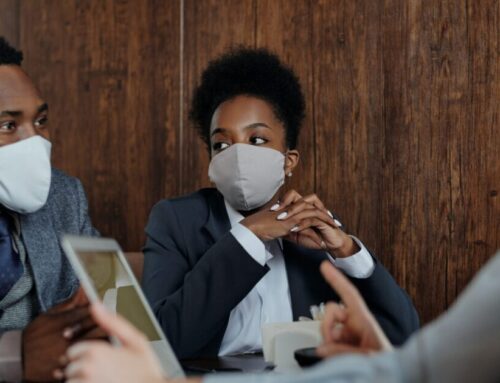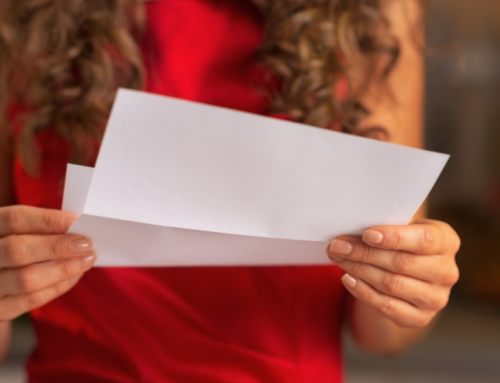Publishing note: This article is an adaptation of the instructional Haitian Creole video on Visiting the Doctor (available with English subtitles) found above. Hope you find it helpful!
Being sick stinks. That’s why visiting the doctor can be such a stressful and overwhelming time. In this article, we look at a few simple questions that can make things go much smoother:
- What’s the standard procedure at the doctor’s office?
- How can you better communicate with your doctor?
- What should you bring with you to an appointment?
What’s the standard procedure when visiting the Doctor?
When you arrive at the office, approach the front desk, and let them know you’re here for your appointment. They may ask for your ID, and insurance card and they’ll likely have you sign in.
Your first time visiting the doctor at a particular office, you may be surprised by the amount of paperwork to fill. But all these papers have a purpose. To allow the doctor to provide the proper treatment needed, while meeting legal liability requirements.
Within these documents, one element comes up again and again: Consent. Consent is permission one person gives by making it known that they agree for something to be done. Each paper you sign is intended to ensure that you consent to or accept what that page talks about.
Some ask whether you consent to treatment, as well as examinations and tests to diagnose what may be ailing you. Others ask who you authorize to receive confidential information about your health. For example, could they leave a voicemail on your home phone with your next appointment date? Is your child allowed to hear results of your test? And so forth.
Others inform you of how your information will be used. Meaning they won’t divulge your information with just anyone, but only to professionals who are entitled to it as part of their duties. And you have a right to know who receives such information.
Also, they need your permission or authorization to seek payment for their services, be it from insurance or elsewhere.
Other paperwork you may receive asks about your health. This includes questions about your current health problem, such as:
- When did the symptoms start?
- Have you felt this way before?
There may be general questions too:
- Do you have high blood pressure? Diabetes?
- Do you have family history of these diseases?
- What medications are you taking? And so on.
These questions may go in depth and they may even be repetitive. You may grow tired of answering question after question, but the reason your answers are important is that they will help these medical professionals to better identify the problem and it will help them treat it without negatively affecting your health in some other way.
In another article, we’ll cover in greater depth, what you should know about filling out paperwork in the US.
Once you’ve finished all the devoir, you may spend some time waiting in the reception area or waiting room. Next, a nurse will call you back once you’re up. They’ll bring you back to the exam room and get you ready for the doctor to come by. They may ask other questions and take some measurements, like your weight and blood pressure. Finally, you’ll wait for the doctor’s arrival.
How can you better communicate with your doctor?
Your relationship with your doctor is based on mutual trust. Doctor’s can often appear rushed, as they may be consulting several patients at a time. However, there are some things you can do to make things go smoother.
- Even before going, think about what questions you’d like to ask. You can even write them down.
- Pay close attention to what the doctor. Maintaining eye contact can show that you’re listening.
- Ask if it’s OK for you to record the conversation. If they allow you to, you can record it on your phone.
- You can even take notes, as long as it doesn’t distract you. Our memory can be spotty at times, wouldn’t you agree?
To diagnose the problem, the doctor may touch the affected area, testing for sensitivity. For example, if there is a sprained or injured joint, the doctor may carefully bend the joint. They may have you undergo tests, like blood tests, x-rays, MRIs, and so on. But above all, they’ll ask questions.
It helps the doctor to know what pain you’re experiencing. In the American terms, pain can be described 2 ways. It’s “intensity” and it’s “type”.
Note: even though, these 2 things go hand-in-hand, in a way, they are 2 different things.
The intensity of the pain is how much you feel it. Maybe, it hurts a bit…maybe it hurts a lot…maybe it’s killing you! To describe the intensity, you may be asked to give a number.
Imagine a scale or barometer going from 0 up to 10. 0 means you have no pain whatsoever. The more pain you feel, the higher number you give. 10 means intolerable pain. 10 is the worst pain you can imagine. There’s no pain worse than 10. The rest of the numbers represent pain between those 2 extremes.
Now, to talk about “type” of pain, the doctor might ask what the pain is like. Is it throbbing? Sharp? Burning? Itching? Or is the limb completely numb feeling?
Something that can help you overcome the language barrier is your interpreter. For advice on how to get the most out interpreting services, check out our upcoming article.
What should you bring to your appointment?
Of course, if asked to bring something, please don’t forget it at home! Whether it’s papers or something else. For that reason, it’s good to ask the person who calls to tell you about the appointment whether you need to bring anything, in particular.
Like we mentioned earlier, you should bring your ID and insurance card (if you have insurance). It’s very important for you to inform them of any medications you’re taking. But rather than walking around with your prescriptions, why not take a picture of the label, that way you can let them know what they are exactly.
Also, if you want to take notes, you can bring a small notebook and pen or you can use your phone.
So now I hope the next time you’re visiting the doctor, you’ll feel more relaxed.
Find out more about whether our interpreting services can help you here.
Vèsyon Kreyòl la
Pa gen moun ki kontan lòske li malad. Se poutèt sa, al kay doktè se yon moman ki ka bay anpil tèt chaje ak kè sote. Nan atik sa, nou pral pale sou kèk bagay ou ta dwe konnen, ki ka fè vizit sa pi byen pase :
- Ki pwòtokòl ki gen pou swiv kay doktè ?
- Ki jan ou kapab kominike pi byen avèk doktè ou ?
- Epi, ki sa ou ta dwe pote pou randevou a ?
Ki pwòtokòl ki gen pou swiv kay doktè ?
Lè w rive nan kay doktè a, w ap abòde moun nan resepsyon pou fè yo konnen ou la pou randevou a. Yo gendwa mande idantifikasyon ou, kat asirans ou (si w gen youn), epi yo ka fè w make non ou sou fèy de prezans lan.
Premye fwa ou al nan yon kabine anpatikilye, ou ka sèzi wè pakèt papye resepsyon an ba ou ranpli. Men tout papye yo bay gen yon objektif, se pou asire doktè a kapab ba w bonjan swenyay k ou bezwen an epi pou yo respekte lalwa pandan y ap fè sa.
Nan tout papye sa yo, youn nan eleman ki parèt plizyè, se sa ki rele « konsantman ». Konsantman, se pèmisyon yon moun bay lòske li fè konnen li dakò pou yon bagay fèt. Nan klinik lan, chak papye yo fè w siyen, se pou yo asire ou konsanti, sa vle di ou dakò sa paj la di.
Gen papye ki mande si ou pèmèt moun yo ba w tretman epi pou yo fè egzaminasyon ak tès dekwa pou yo sonde maladi ou genyen. Genyen ki mande ki moun ou otorize pou jwenn enfòmasyon konfidansyèl anrapò ak sante ou. Pa egzanp, èske yo ka kite yon mesaj vokal ak dat randevou nan telefòn lakay ou ? Èske pitit ou gendwa tanda rezilta tès ou ? Etsetera.
Genyen tou ki fè w konnen ki izaj y ap fè ak enfòmasyon ou, sa vle di yo pap kouri met biznis ou nan lari, men se sèlman lòt pwofèsyonèl ki sipoze jwenn enfòmasyon sa ki pral jwenn li, epi ou gen dwa pou ou konnen ki moun resevwa li.
Epitou yo bezwen pèmisyon oswa otorizasyon ou pou yo resevwa peyman pou sèvis yo, keseswa nan men asirans ou y ap jwenn kòb sa oubyen ayè.
Lòt papye yo ba w ap poze kesyon sou sante ou. Sa gen ladan l kesyon sou maladi ou gen kounye a :
- Depi ki lè sentòm yo kòmanse ?
- Èske w konn santi w konsa anvan ?
Yo gendwa poze kesyon jeneral tou :
- Èske w fè tansyon ? Sik ?
- Èske gen moun nan fanmi w ki gen maladi sa yo ?
- Ki medikaman w ap pran ?
Kesyon sa yo vreman detaye e yo ka menm repete menm kesyon an nan plizyè fwa. Ou gendwa bouke reponn tout kesyon sa yo. Men, rezon ki fè yo enpòtan, se paske repons ou bay ap pèmèt yo pi byen wè sa ki pwoblèm nan epi sa ap ede yo trete pwoblèm nan san yo pa nui sante w yon lòt jan.
Nan yon lòt atik, n ap esplike an plis detay ki sa ou ta dwe konnen sou ranpli papye Ozetazini.
Apresa ou gendwa fè yon bon ti tan ap tann nan sal de resepsyon. Lèfini, yon enfèmyè ap rele w lè se tou pa ou. L ap mennen w nan sal de konsiltasyon, l ap prepare w pou vizit doktè a. Li ka poze w lòt kesyon epi li gendwa pran kèk mezi tankou pèz ou ak tansyon ou. Apre sa, w ap tann doktè a vini.
Ki jan ou kapab pi byen kominike avèk doktè w?
Relasyon ou genyen ak doktè a baze sou konfyans youn nan lòt. Souvan, doktè yo ka genlè prese paske yo kapab ap konsilte ak plizyè pasyan. Men, gen kèk bagay ou kapab fè pou fè bagay yo mache pi swa:
- Menm anvan w ale, reflechi ki kesyon ou vle poze. Ou ka menm mete yo alekri.
- Swiv sa doktè a di ak atansyon. Lòske w gade l nan zye, sa montre w ap prete atansyon.
- Mande doktè a si li aksepte w tepe konvèsasyon an. Si li dakò sa, ou ka sèvi ak sèlilè ou pou anrejistre konvèsasyon an. Ou kapab menm pran nòt, toutotan sa pa fè w distrè. Gendelè memwa pa fidèl, ou pa dakò ?
Pou li dyagnostike pwoblèm nan, doktè a ka manyen pati ki afekte a pou wè si l sansib. Pa egzanp, si se yon jwenti ki frape oubyen ki foule, doktè a ka jwe jwenti sa a dousman. Li kapab fè yo fè tès tankou tès san, radyografi, MRI, etsetera. Men sitou li pral poze kesyon.
Sa ede doktè a anpil lè li konprann doulè ou genyen. Ozetazini, yo konsidere doulè gen de bagay ladan l : severite ak kalite.
Tande: menm si de bagay sa yo mache ansanm, nan yon sans yo se de bagay diferan.
Severite doulè a se mezi ou santi doulè a. Donk, li ka fè w mal toupiti, li ka fè mal anpil, li ka ap touye w menm. Pou dekri severite doulè a yo gendwa mande yon chif oswa yon nimewo. Imajine yon echèl ki kòmanse a 0 epi ki monte a 10. 0 vle di ou pa gen doulè menm. Plis doulè ou genyen, pi gwo nimewo ou ap bay. 10 vle di yon doulè ou pa ka sipòte. 10 reprezante pi gwo doulè ou ka imajine. Pa gen doulè pase 10. Epi rès nimewo yo reprezante doulè ki ant 2 ekstrèm sa yo.
Kounye a pou pale de kalite doulè. Doktè gendwa mande w ki jan doulè a ye. Kòmsi, èske doulè a ap lanse w, èske l ap pike w, boule w, grate w? Oubyen èske w santi li angoudi oubyen li mouri menm ?
Sa ki kapab ede w simonte baryè lang nan, se entèprèt ou. Pou plis konsey sou ki jan ou kapab pi byen pwofite sèvis entèprèt ou, veye pwochen videyo nou. Ou ka tcheke la annatandan.
Ki sa ou dwe pote nan randevou a ?
Nòmalman, si yo mande pou ou vini ak yon bagay, tanpri pa bliye l lakay. Sa kapab gen ladan l kèk papye oswa yon lòt bagay. Se poutèt sa li toujou bon pou ou mande moun ki rele di w randevou a « Èske m bezwen pote yon bagay ? »
Jan nou te di sa pi wo a, se pou ou gen idantifikasyon ou ak kat asirans ou.
Li vreman enpòtan pou ou fè yo konnen ki medikaman w ap bwè. Men olye w mache ak tout preskripsyon w, poukisa ou pa fè foto etikèt yo, konsa ou ka di yo egzakteman.
Anplis, si ou vle pran nòt ou kapab mache ak yon ti kaye ak plim obyen ou ka fè nòt nan telefòn ou.
Alò kounye a, mwen swete pwochenn fwa ou gen pou w al kay doktè w ap santi w pi alèz.
Si w vle konn plis bagay sou sèvis nou, ou ka mande yon konsiltasyon kounye a.




